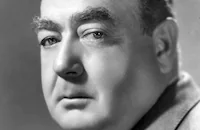Storm at Daybreak

Brief Synopsis
Cast & Crew
Richard Boleslavsky
Kay Francis
Nils Asther
Walter Huston
Phillips Holmes
Eugene Pallette
Photos & Videos
Film Details
Technical Specs

Synopsis
On 28 Jun 1914, in the town of Sarajevo, Austrian Archduke Francis Ferdinand and his consort are assassinated by a Serbian nationalist while parading in an open automobile. After war is declared by Austria against the kingdom of Serbia, many Serbian villagers are drafted into the Hungarian army. Because of their in-bred hatred of the Hungarians, the Serbian men resist the draft and a few risk desertion. Three such deserters hide out at the estate of Dushan Radovic, a small-town mayor, and are protected by Dushan's sympathetic wife Irina. When Captain Geza Petery, the commander of the local Hungarian forces, arrives at the estate to search for the deserters, he is met by the beautiful Irina, who feigns ignorance of the situation. Unaware of Irina's actions, Dushan, an old friend of Geza's then innocently gives his word that he is not hiding any deserters. Although suspicious, Geza declines to search Dushan's grounds and accepts an invitation to dine. During the evening, Irina reveals the truth about the deserters to Dushan and begs him to aid in their escape. While Irina then distracts Geza with mild flirtation, Dushan arranges for the deserters to flee. Later, Geza quietly reveals to Irina that he was well aware of the escape plan, then confides in Dushan that Panto Nikitch, his steward, had informed him of the deserters' presence. Furious at Panto's betrayal, Dushan orders his servant to sign a retraction and dismisses him. On the eve of their departure to the front, Geza and his unit return to Dushan's estate for a last night of revelry. During the drunken festivities, Geza finds Irina alone and confesses that he is in love with her. Although Irina also admits to loving Geza, she insists that, for Dushan's sake, they not act on their passions. Sometime later, while distributing apples to wounded Hungarian soldiers on a train, Irina comes across Geza, who has been seriously injured. Unable to remain with him, Irina tells Dushan about Geza's condition, and the unsuspecting Dushan arranges for Geza to recuperate on his estate. Although Irina is overjoyed that Geza is alive, she worries that his constant presence in her home will dissolve her will. Later, Dushan confides in Geza his suspicion that Irina is not in love with him and adds that, if he ever lost Irina to another man, his world would crumble. Thus warned, Geza decides to assume a new command in town and, after kissing Irina farewell, leaves the estate. After the Armistice, Serbia declares its independence from Hungary, and Geza is replaced by Dushan's former steward, Panto, who has risen to the rank of commissioner. As Geza prepares to leave Dushan's town, Irina comes to him and begs him to take her with him. As soon as Geza agrees, however, Irina realizes that, as long as Dushan lives, neither she nor Geza will find happiness together. At that moment, Dushan finds Geza and offers him a job as overseer of his estate. When Geza refuses the offer, Dushan finally senses the emotions between Geza and Irina and begins to brood. That night, during a party at Dushan's house, Panto shows up and brags that he has a warrant to search Geza's official papers for possible evidence of treason. Sure that the search will result in Geza's demise, Irina begs Dushan to warn the Hungarian before Panto finds him. Enraged with jealousy, Dushan refuses, forcing Irina to go to Geza's post herself. While Irina is with him, Geza is confronted by a crazed Dushan, who starts to strangle him for refusing to admit to adultery. Eventually Dushan calms down, and while maintaining her fidelity, Irina confesses that Geza and she are indeed in love. Although crushed by the admission, Dushan informs Panto that Geza and Irina have already fled together. Panto is amused by Dushan's apparent humiliation and agrees to ride with him to find the officer. While driving his carriage, however, Dushan becomes wild and, after revealing his deception to a terrified Panto, steers the coach into a raging river. Thus freed, Geza and Irina face the future together.

Director

Richard Boleslavsky
Cast

Kay Francis

Nils Asther

Walter Huston

Phillips Holmes

Eugene Pallette

C. Henry Gordon
Louise Closser Hale

Jean Parker

Etienne Girardot

Mischa Auer

Leonid Kinsky
Ferdinand Munier
James Bell
Hal Bover
Allan Fox
Frank Burke
Rychard Cramer
Crew
Adrian
Dr. William Axt
Dr. William Axt
Margaret Booth
George Folsey
Lucien Hubbard
Gus Kahn
Bertram Millhauser
Douglas Shearer
William N. Sparks
Earl Taggert
Alexander Toluboff
Edwin B. Willis

Photo Collections
Film Details
Technical Specs

Articles
Storm at Daybreak -
By Frank Miller

Storm at Daybreak -
Quotes
Trivia
Notes
The working title of this film was Strange Rhapsody. According to the Variety review, Sándor Hunyady's play was bought by M-G-M two years before the film went into production. Variety also notes that the play was produced in Budapest and Vienna, although no dates for these stagings have been found.














